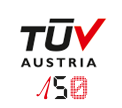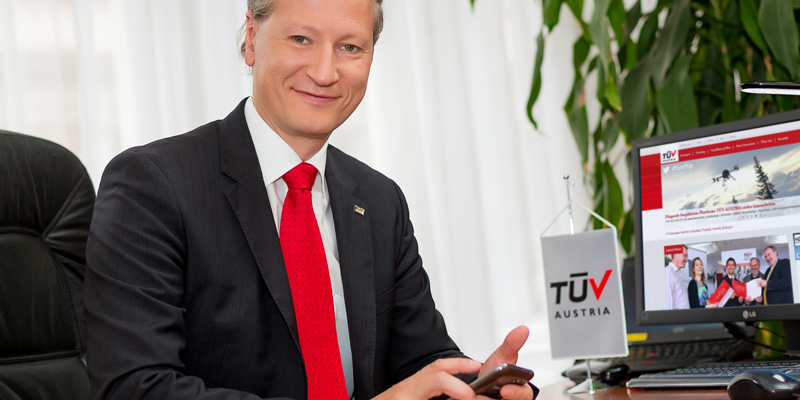TÜV AUSTRIA - 145 years of safety: From inspection to innovation
- 06/11/2017
- Marketing
- Created by TÜV AUSTRIA Group
by Alexander Kohl, Business People
The history of TÜV AUSTRIA began 145 years ago on June 11 1872 with the founding of the “Dampfkesseluntersuchungs- und Versicherungsgesellschaft” [Steam Boiler Inspection and Insurance Company]. A lot has happened since then …
That’s true. TÜV AUSTRIA was founded during the first Industrial Revolution. The idea was for us to act as an advisor to industry during development because in the early days of steam technology it experienced some difficulties. The new trend these days is “Industry 4.0”; we were active even during “Industry 1.0”.
What is the company’s role today? Something like “TÜV 4.0”?
We have long since gone beyond testing, monitoring and inspection. We want to act as advisors to technological development. Industry 4.0 is currently emerging. There are as yet no standards or regulations in accordance with which to perform tests, they are only just in the process of being established. But we don’t want to wait that long. We want to be there right from the start to meet the challenges involved.
Can you specify the nature of these challenges?
On the one hand, the idea of Industry 4.0 offers considerable advantages in terms of flexibility thanks to networked production. On the other hand, the system as a whole becomes more exposed. As a result, we have to discuss matters of security on a whole new level. Since the Stuxnet virus in 2010 at the latest, we know that industrial control systems are just as vulnerable to attacks from outside.
Imagine what would happen in a completely networked production chain when one element in this chain suffered extended disruption due to a hacker attack or industrial espionage. Production is exposed to dramatically higher levels of risk these days. And we have to be proactive in counteracting this risk.
At the moment, industry is engrossed in the 4.0 hype. What is the level of awareness regarding IT security?
In my opinion, it is not given adequate consideration but we have to keep a watchful eye on the matter: a fully automated production site is simply heaven for hackers. Many of them will try to get in there – and some will succeed. Sometimes with catastrophic consequences. This is why we have to address the subject from a conceptual point of view, starting with the first link of the development chain. Besides IT security, there is also the factor of physical safety.
WATCH: TÜV AUSTRIA & Human-Robot-Collaboration on You Tube
As with the latest human-machine assemblies, for example. These innovations are fascinating: ultra-heavy loads are lifted by robots while a human performs precision assembly work on a different part of the workpiece. There used to be separate secure areas. Now they are merging. This means that much higher levels of safety will have to be guaranteed than today.
Which measures does TÜV AUSTRIA take to provide for these new levels?
We want to act as midwives for the necessary technologies. This also applies to communication standards. We must keep in mind that the fully automated machines have to communicate with each other. The main question at the moment is how and according to which parameters. There is an ongoing standardisation dispute between US American and German companies. Regardless of who will define the standard in the end, matters of IT security will have to be considered from the start. We will act as observers and make sure that this criterion is met.
What are the weakest spots in a fully automated production plant and what can entrepreneurs do to prevent a possible attack?
All objects in a production plant need to be clearly identified if they are to work together flexibly: machine, workpiece, raw material – each object must be locatable and identifiable, for example by attributing individual IP addresses to them. But today this also means: vulnerability. A production system therefore needs to be designed in a way that prevents security gaps right from the start: by integrating relevant mechanisms, by preferential use of internal networks, by requesting logs, etc.
When do you expect the global breakthrough of 4.0?
I don’t believe that there will be an all-encompassing revolution, as many assume. It will be an evolutionary change. I don’t expect companies to manufacture their products in an entirely different way ten years from now. But some aspects of 4.0 will be applied by then. It’s industry’s age-old dream of a lot size “one”. The dream of all lean-management experts is to achieve production efficiency for each individual customer without cost disadvantage. Industry 4.0 is the means to get there. This is why this “(r)evolution” cannot be stopped.
A further topic currently under discussion among representatives of domestic industry and commerce is “energy efficiency”. The new relevant law is intended to pave the way for it in Austria ...
Yes, that’s the plan, but allow me to interject: I am very sceptical whether that law is the proper stimulus to achieve this.
Why?
The issue is being addressed from the wrong angle in Austria. It would be important for companies to become aware of the potential inherent in energy efficiency. I have worked in industry for many years and I know that dealing with this subject can act as a substantial trigger: millions of Euros can be saved by making comparatively small expenditures. When this is forced on market participants, I fear that many will concentrate solely on observing the laws and updating verifications instead of actively utilising the potential.
There are still some further uncertainties regarding the Energy Efficiency Act (Energieeffizienz-Gesetz – EEffG). Both the guideline regulation and the competent monitoring body have yet to be determined …
True. We get many inquiries on this subject from various branches of industry. We at TÜV AUSTRIA will assist our customers in implementing the law. But we suspect that entrepreneurs will be less concerned with actually saving energy than with meeting the requirements of the EEffG to the last detail. It’s worth taking a look at Germany in this context. The topic has been dealt with very differently by industry there, they are really fighting for it. The legislative body has acted more decisively and created much more awareness for energy efficiency. Unfortunately, Austria lags behind in this respect.
Where is the place to start saving energy in a classical business?
There are countless ways to approach the subject. All production cycles can be improved: waste heat, motors, supply chains. Lighting is also an issue – especially the use of daylight. Last but not least, fleet management is a factor as well. In the production industry, the most significant aspect is often neglected, however: product design. How much energy can be saved by slight adaptations to the product? This is well worth taking a closer look. We are happy to be there for our customers from the beginning in this respect as well, given that there is room for the most groundbreaking innovations particularly in this area.
Interview with Dr. Stefan Haas: From inspection to innovation, Photo: Ludwig Schedl, (C) TÜV AUSTRIA.

